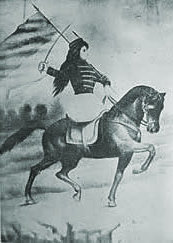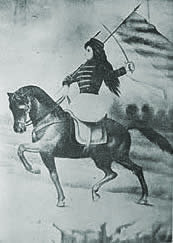
|
Women and Independence in Latin America An exploration of women's involvement in the Latin American Wars of Independence |

|

|
Women and Independence in Latin America An exploration of women's involvement in the Latin American Wars of Independence |

|
Other names: La Difunta Correa
Gender:Female
Ethnic origen: Unknown
Events:
| 1840? | - | La Rioja | - | Unknown | - | She lived on the border of San Juan and La Rioja during Facundo Quiroga's rule. |
| 1845 | - | San Juan | - | Unknown | - | She is said to have died from lack of water in the 1840s. |
Connections:
Mythical/ folkloric womenBiography:
A campesina who lived on the border of San Juan and La Rioja during Facundo Quiroga's rule. Her father was a veteran of the independence wars, but was persecuted by Quiroga after the death of the governor of San Juan, Plácido Fernández de Maradona. She married campesino Clemente Bustos who later (in the 1840s) joined the Quiroga's troops leaving her and their baby son. She could not bear the separation and took up her son and walked after the troops towards La Rioja. She died of thirst and from the wounds on her feet close to Vallecito on the slopes of Pie de Palo. She was found by a group of muleteers, the baby was at her breast, still alive. They buried Correa and took the child to the village. Moved by the story, the villagers visited her grave, which eventually became a pilgrimage site. (Sosa de Newton, 153-154)
Her story has become incorporated into folklore and there are many shrines with her image throughout Argentina. Truck drivers leave candles and water for her as well as spare engine parts. Thousands of pilgrims visit her shrine at Vallecito, said to be the place of her death. (Lonely Planet, p.347)
References:
Boa, Sandra, Greensfelder, Ben and Hubbard, Carolyn (2002) Argentina, Uruguay and Paraguay
Sosa de Newton, Lily (1986) Diccionario biográfico de mujeres argentinas